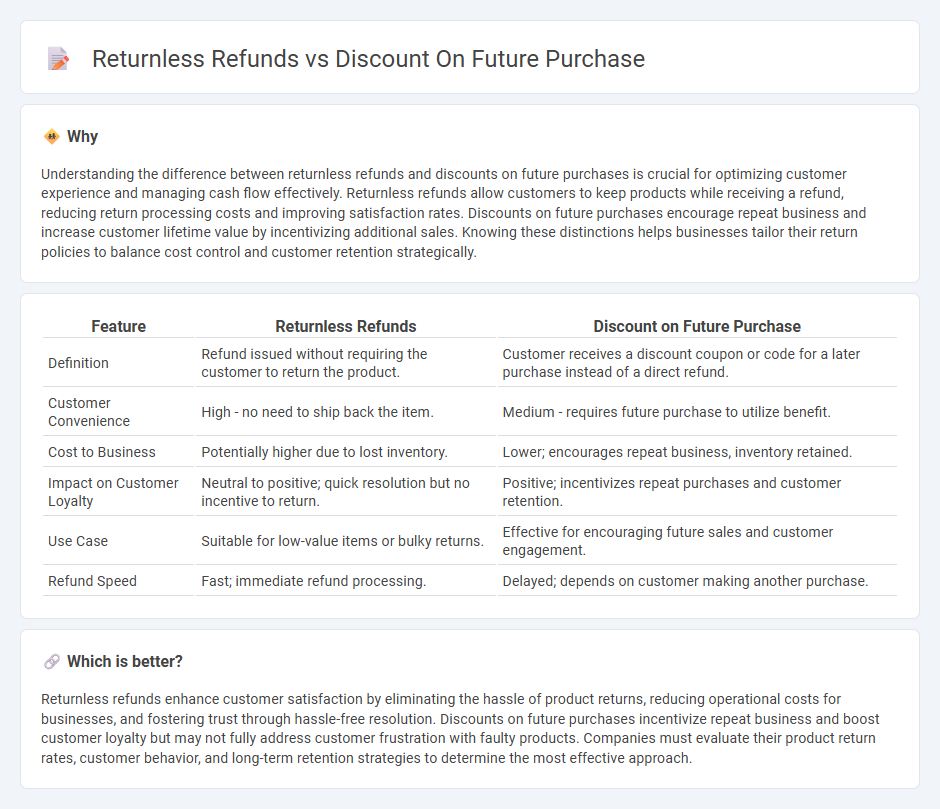
Returnless refunds enhance customer satisfaction by allowing consumers to receive a full refund without the hassle of returning products, reducing logistical costs for businesses. Offering discounts on future purchases incentivizes repeat sales and fosters customer loyalty by encouraging continuous engagement with the brand. Explore the benefits and drawbacks of both strategies to optimize your commerce approach effectively.
Why it is important
Understanding the difference between returnless refunds and discounts on future purchases is crucial for optimizing customer experience and managing cash flow effectively. Returnless refunds allow customers to keep products while receiving a refund, reducing return processing costs and improving satisfaction rates. Discounts on future purchases encourage repeat business and increase customer lifetime value by incentivizing additional sales. Knowing these distinctions helps businesses tailor their return policies to balance cost control and customer retention strategically.
Comparison Table
| Feature | Returnless Refunds | Discount on Future Purchase |
|---|---|---|
| Definition | Refund issued without requiring the customer to return the product. | Customer receives a discount coupon or code for a later purchase instead of a direct refund. |
| Customer Convenience | High - no need to ship back the item. | Medium - requires future purchase to utilize benefit. |
| Cost to Business | Potentially higher due to lost inventory. | Lower; encourages repeat business, inventory retained. |
| Impact on Customer Loyalty | Neutral to positive; quick resolution but no incentive to return. | Positive; incentivizes repeat purchases and customer retention. |
| Use Case | Suitable for low-value items or bulky returns. | Effective for encouraging future sales and customer engagement. |
| Refund Speed | Fast; immediate refund processing. | Delayed; depends on customer making another purchase. |
Which is better?
Returnless refunds enhance customer satisfaction by eliminating the hassle of product returns, reducing operational costs for businesses, and fostering trust through hassle-free resolution. Discounts on future purchases incentivize repeat business and boost customer loyalty but may not fully address customer frustration with faulty products. Companies must evaluate their product return rates, customer behavior, and long-term retention strategies to determine the most effective approach.
Connection
Returnless refunds enhance customer satisfaction by allowing shoppers to keep unwanted items while receiving instant reimbursement, thereby reducing return processing costs for retailers. Discount on future purchases incentivizes repeat sales by encouraging customers to spend the refunded amount on other products, fostering customer loyalty and increasing lifetime value. Both strategies optimize the post-purchase experience and strengthen the commercial relationship between businesses and consumers.
Key Terms
Customer Retention
Discounts on future purchases encourage repeat buying behavior by providing customers with an incentive to return, effectively boosting customer retention and lifetime value. Returnless refunds enhance customer satisfaction by resolving issues quickly without the hassle of product returns, fostering trust and loyalty. Explore how these strategies optimize customer retention in your business model.
Incentive Programs
Discounts on future purchases encourage customer retention by providing monetary incentives that increase the likelihood of repeat business, enhancing long-term sales growth through loyalty programs. Returnless refunds reduce return-related costs and improve customer satisfaction by offering quick resolution without product returns, benefiting operational efficiency. Explore how integrating these incentive programs can optimize your customer experience and maximize profitability.
Reverse Logistics
Discounts on future purchases streamline reverse logistics by reducing the volume of returned items and enhancing customer retention through incentive-based returns. Returnless refunds eliminate physical returns, cutting transportation and processing costs but require robust fraud prevention measures to safeguard revenue. Explore how optimizing these strategies improves reverse logistics efficiency and customer satisfaction.
Source and External Links
How Next Order Coupon Benefits your Shopify Store? - A discount on future purchases, often given as a next purchase coupon, helps drive repeated sales, improves customer retention, and motivates customers to return and shop again at your store.
A Guide to Discounts and Promotions for D2C Brands - Offering a discount on a future purchase is a tactic to encourage repeat purchases by getting customers to come back, though it may be less effective for one-time buyers.
11.8 Vouchers, Discounts, and Coupons | DART - Future purchase discounts like vouchers can be part of a negotiated contract providing customers a material right, creating a performance obligation for the business under accounting standards.
 dowidth.com
dowidth.com